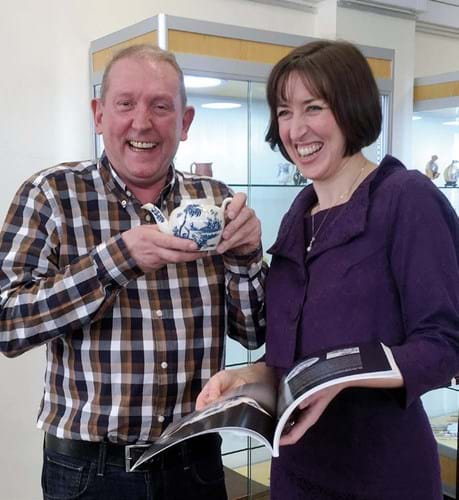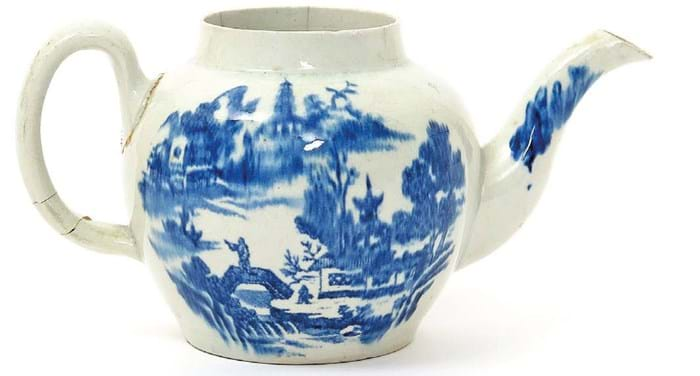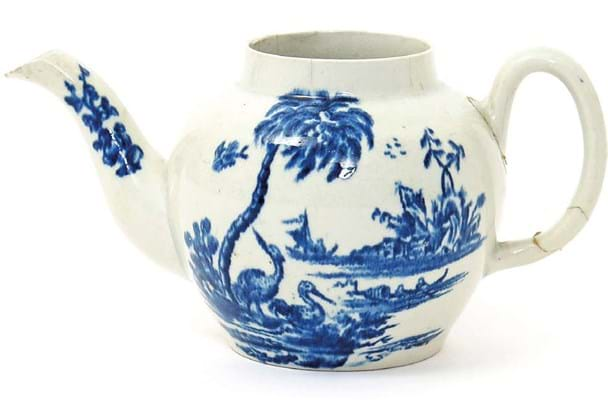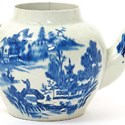The vessel, only the seventh piece known from the John Bartlam factory in Cain Hoy, South Carolina, was purchased in the room by London porcelain dealer Rod Jellicoe bidding for the Metropolitan Museum of Art in New York.
The history of porcelain in the West can be both challenging and technical but this vessel tells a much simpler story: it is America’s oldest china teapot.*
The factory operated by Staffordshire potter Bartlam on the Wando river c.1765-70 is now recognised as the first to produce porcelain in America, preceding by about five years the better-known American China Manufactory run by Gousse Bonnin and George Morris in Philadelphia from 1769-72.
Low-fired phosphatic soft paste porcelain sherds almost akin to pearlware were found at the Cain Hoy kiln site in 2007, followed by the sensational discovery, in a number of English collections, of a series of four matching blue and white teabowls and two different saucers.
All shared a common source – a Berkshire auction in 2002 – and were initially thought to be products of the Isleworth factory. Reattributed, all are now in American collections.
In April 2010, Jellicoe, an active member of the American Ceramics Circle, sold a teabowl from his own collection to the Chipstone Foundation in Milwaukee for a price in the region of $50,000-75,000.
A second was acquired by the Philadelphia Museum of Art in 2012 for $75,000, while another described as ‘the property of an English collector’ was sold at a Christie’s New York Americana sale in January 2013 for $120,000 (£76,000).
£15 Lincolnshire find
The vendor of the teapot, a private collector, had bought it at a sale in Lincolnshire in 2016 for just £15.
It was in a sorry condition – minus a cover and the handle broken and restuck – but Clare Durham, ceramics specialist at Woolley & Wallis, agreed it fell outside the standard corpus of English porcelain. In time, a connection was made between the ably-engraved transfers and one of two known Cain Hoy saucers. The paste corresponded with that of all other known Bartlam pieces.
Bidding for the last lot in a February 20 sale of English and Continental ceramics involved just three parties.
With potential purchasers playing their cards close to the chest in the run-up to the sale, the contest opened sedately at £10,000 and first climbed in increments of £1000. One bidder dropped out at what proved a modest £22,000.
However, thereafter, Jellicoe, holding the biggest bid of his 40-year career, began to exchange mighty blows with a phone bidder from the US, described by the auctioneers as a private collector.
With premium the Met will pay close to £600,000, or $840,000.
‘This came out of the blue’
Rod Jellicoe told ATG he had approached the Metropolitan Museum of Art with an eye to purchasing the Bartlam teapot when news of its discovery filtered out in December. “I knew it was a gap in their collection – they have several pieces of Bonnin and Morris but no Bartlam – and it really was the best place for it to go. We discussed it over a number of weeks and finally came up with a number.”
The price of a ‘birth of a nation’ object was near-impossible to call but Jellicoe had prior experience of American ‘porcelain fever’.
“Shortly after I sold the first piece of Bartlam to the Chipstone, it was put on display at The Winter Show in New York in a huge glass cube manned by body guards. It wasn’t a tea bowl, it was a national treasure.”

Dealer Rod Jellicoe and Woolley & Wallis ceramics specialist Clare Durham shortly after the sale of the Bartlam teapot for £460,000.
Quite why all examples of Cain Hoy porcelain have been found in Britain is a matter for conjecture, but perhaps Bartlam returned home with some stock when his American enterprise ceased in 1773. As colonial novelties, they may have had a better chance of preservation.
Jellicoe doubts there are many more Bartlam pieces to find. “From the excavations at the William Reid and Samuel Gilbody factories in Liverpool and at Isleworth we have an idea of the survival rate of early porcelain – and it is a tiny fraction of 1% of what was made. The Bonnin and Morris factory was first discovered in 1967 and since that time only 20 or so pieces have come to light.
“It is 10 years since the Cain Hoy findings were published and I started to think no more would surface. This came out of the blue.”
Fresh information
* Scholarship in this field continues to surprise. Discoveries are shedding light on the embryonic days of porcelain production in America in the era of the Nonimportation Agreements and calls to boycott English goods.

This teapot, discovered during excavations in Philadelphia, is thought to be only the second known example of American made hard-paste porcelain.
Excavations on the site of the new Museum of the American Revolution in Philadelphia have yielded rich deposits of 18th century material culture – including two examples of an American hardpaste porcelain c.1765-70 by an unknown factory.
A fragmentary punch bowl exhibited at the 2017 New York Ceramics & Glass Fair was followed at this year’s event in January with the display of a blue and white teapot.


















